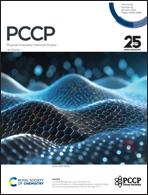From skin sensitizers to wastewater: the unknown photo-deactivation process of low-lying excited states of isothiazolinones. A non-adiabatic dynamics investigation†
Abstract
Isothiazolinones represent a class of heterocyclic compounds widely used in various applications, including as biocides in cosmetics, detergents, and paints, as well as in industrial wastewater treatment. Indeed, the presence of isothiazolinones in the environment and their associated potential health hazards have raised significant concerns. In this study, a non-adiabatic dynamics investigation was conducted using state-of-the-art methodologies to explore the photochemistry of isothiazolinones. A simplified model, isothiazol-3(2H)-one (ISO), was employed to represent this compound class. The study validated the model and demonstrated that ISO can return to its ground state through the cleavage of the S–N or S–C bonds, with no significant energy barrier observed. Non-adiabatic dynamics simulations provided insights into the time scales and detailed processes of isothiazolinone photodissociation. The preferred route for deactivation was found to be the cleavage of the S–N bond. This research enhances our understanding of the photodeactivation processes of isothiazolinones and their potential environmental impact.

- This article is part of the themed collection: Celebrating Latin American Chemistry


 Please wait while we load your content...
Please wait while we load your content...